
I have decided to dedicate a few lines to this fish of the Scombridae family for several reasons.
First of all, because it is a highly endangered marine species.
Second, because it is a really nice fish (grilled and raw it is unbeatable) and nutritious.
Third, because it amazes me that it is best known for coming in a can.
Fourth, because its majestic appearance in the sea and its great resistance to being caught amaze me.
Fifth, because it seems necessary to me to protect this great swimmer extraordinarily adapted to the pelagic conditions of its existence. To savor this animal is an emblematic act. It is a gentleman in the waters of the planet.
Ode to the tuna so that it does not disappear.
I am going to focus on bluefin tuna (Thunnus thynnus), a highly endangered species on the verge of disappearing due to indiscriminate fishing, clarifying beforehand that the tuna we consume in canned food generally comes from the smaller white-fleshed species. Bluefin tuna (like other large tuna) is highly prized in kitchens, especially in oriental kitchens for its red meat. It weighs more than 700 kilos and is more than four meters long. It is highly sought after as it is the ideal ingredient for sushi and sashimi.
It is mercilessly hunted and must be in the top ten of the most endangered fish on the planet. It lives in the North Atlantic Ocean and the Mediterranean Sea. There is another species of tuna (Thunnus orientalis) that lives in the Pacific Ocean and is also known as bluefin tuna; therefore, it suffers the same fate.
Tuna belong to the few warm-blooded fish species that "warm up" with the constant movement of their powerful muscles. This explains how they can hunt at very low temperatures, keeping their bodies around 27 °C (almost like mammals). Tuna are very fast (they can reach 80 kilometers per hour) and it is estimated that in a couple of weeks they can cross all the oceans of the planet. Several scientists have tried to imitate their anatomical configuration to create similar robotic structures. All in vain, since it is impossible to match this perfect creature.
Tuna hunt like wolves, that is to say, in packs encircling their victims and swallowing almost everything that moves in the sea, because due to their accelerated metabolism, they need to ingest food permanently. Their diet consists of fish, squid, small sharks, seahorses, crabs and even sea sponges. More than a century ago, tuna was not a highly prized dish and its meat was used to feed cats and dogs. Later, it was included in deep-sea fishing, where the struggle between man and the big fish reached its peak. No more than 50 years ago, the great taste and quality of its meat was discovered.
Beloved tuna.
Contrary to what many may suppose, in Japan, raw fish has not always been a typical dish. In the eastern country, marine species were basically consumed using marinating, smoking and drying techniques for their preservation. This situation changed after World War II, as access to refrigerators and freezers allowed fish meat to be preserved for a longer period of time. This substantially changed the culinary and gastronomic habits of the Japanese. In this way, tuna, until then underestimated by the Samurai, became a delikatess that reached the cost and reputation of truffles or caviar.
Unlike the latter two products, which are scarce and expensive, tuna was (at that time) available in large quantities. It gradually became the star of the best menus in many parts of the world. In 2001, a tuna went for as much as $175,000 in a Tokyo market. Thus, while 40 years ago it was unthinkable to eat raw fish in the United States, today sushi and sashimi can be found in almost every fast food store, in supermarkets and of course in the most expensive and refined restaurants. A dinner for two people based on these two products can cost more than 1,000 dollars. Enjoy your meal.
Tuna is money.
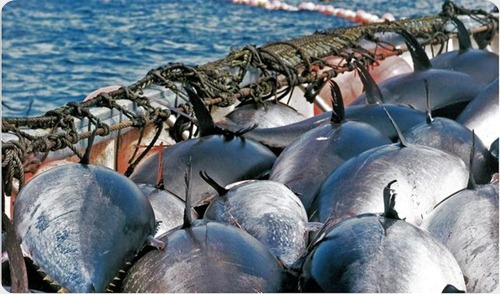
And of course, since a slice of tuna can cost several hundred dollars, it is not surprising that thousands of boats set sail in search of it. At first, the Japanese were limited to fishing in their Pacific territories, but when they noticed that large quantities of tuna were plying the North Atlantic (rather than the Pacific), they did not hesitate to expand their fishing frontiers. Two decades ago it was thought that there were two populations of bluefin tuna on the planet. One was distributed in the western Atlantic and the other occupied and reproduced in the waters of the Mediterranean.
Under this assumption, in 1969, the ICCAT commission (International Commission for the Conservation of Atlantic Tunas) severely restricted the bluefin tuna harvest quota in the western Atlantic, while in the Mediterranean, the fishing restriction was very light. Already in the 1950s and 1960s, some scientists had warned that the tuna did not form two separate populations, but that it was a single one that used the Gulf of Mexico and the Mediterranean for spawning and that its routes crossed in the Atlantic.
Currently, the tuna situation is becoming increasingly critical, as young specimens (that have not yet reached sexual maturity) are caught and taken to sea farms until they reach a size to be slaughtered and sent to Japan. In the Mediterranean, this practice is common and it is believed that by "breeding" tuna, overfishing is combated. In reality, what is actually being done is to ruin a wild population, since the fish are caught before they can reproduce and the adult specimens in captivity hardly grow, nor reproduce. These hatcheries are a real threat that only accelerate the tuna's extinction.
Already in 2006, the WWF (World Wide Fund for Nature) demanded that tuna fishing in the Mediterranean be stopped once and for all, however, due to its high market value, this has not happened. ICCAT ignored the scientific arguments to stop tuna fishing and will maintain the fishing quotas of previous years until 2010. After that year, they would be reduced by 20%. For many experts, these very plausible measures are condemning tuna to disappear. In June 2008, fishing for this species in the Mediterranean had to be halted due to its near disappearance in that part of the planet.
We must save bluefin tuna and other tuna species from extinction. It seems that the only way to do so is by regulating their fishing and -if possible and if we have time- domesticating these predators for breeding and trade. In the second installment I will delve deeper into these points. This magnificent fish deserves our full attention. Let us not allow the disappearance of this marine machine.
One of the measures proposed to curb the indiscriminate fishing of this fish is the establishment of fishing quotas. However, it seems that this would not do much good, as illegal fishing and the black market are difficult to control. More than 75% of the bluefin tuna (about 70,000 tons) caught annually ends up in Japanese markets regardless of where it comes from.
The Japanese themselves do not respect their own laws and catch this fish wherever they can find it. As time goes by, it is becoming increasingly difficult to find these marine creatures. However, the demand is increasing and so are the prices. Fishing for them is therefore an attractive business.
One possibility to reduce fishing would be for the Japanese to stop eating sushi and sashimi, which sounds almost impossible. It is as if they told us to stop eating cebiche. In this scenario, there would seem to be only one possibility left: to domesticate and breed tuna in captivity.
An article by marine biologist John Marra, from Columbia University in New York, published in July 2005 in the specialized journal Nature, entitled: When will we tame the oceans? states that fishing in the seas will eventually annihilate the marine fauna. Marra argues that man has failed in his attempt to regulate such activity and that in a couple of decades, there will possibly be no more to regulate because the seas will have almost nothing (or nothing) to offer us.
Aquaculture.
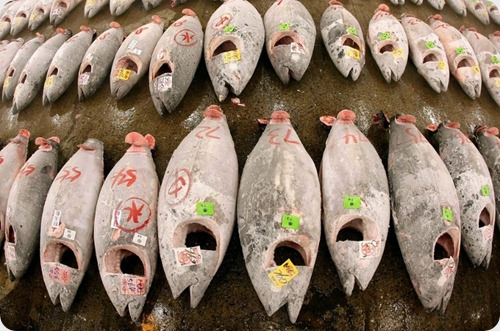
Marra proposes to domesticate marine species. In this way, key species for the fishing industry could be bred and then marketed. However, current aquaculture is harmful (in many cases) because it pollutes the coasts and weakens existing wild fish populations through the transmission of diseases and contact with toxic substances. To avoid this, Marra suggests the use of offshore hatcheries, that is, far from the coast and with extensive surfaces using nets and structures that allow these "large cages" to be moved.
Regarding tuna, Marra proposes the capture and breeding of juveniles to be caught according to demand and when they have the right weight. All this under an adequate management plan that ensures the continuity of the species and done in a way that does not affect its natural cycle. According to this proposal, if bluefin tuna and other tunas are not domesticated, they will disappear in the following years. Alarmed by this situation, the European Union has been supporting tuna research and breeding projects and has even announced some progress in this regard.
For example, German scientists have experimented with tuna in the Mediterranean Sea, specifically in the southern coasts of Italy. The results have been positive, as they have been able to collect several offspring through hormone treatment. One of the first experiences in commercial tuna farming began a few decades ago through the work of the Clean Seas Aquaculture Growout company off the coast of Australia. Currently, this company is working hand in hand with European experts in search of solutions to this problem. The Australian Government is also supporting these initiatives. Encouraging advances have already been reported.
The breeding of these creatures perfectly adapted to the aquatic environment is perhaps at odds with their status as exceptional animals that put up a great fight when caught and are predators par excellence. Their main enemy, man, will possibly have to get used to breed these unique beings if he does not want to see them disappear. An unfortunate truth that cannot be refuted if the seas continue to be plundered all over the planet. These jewels of hydrodynamics deserve greater concern. It is painful to recognize that we have almost annihilated them.
The tuna's only natural enemies are whales. Their great capacity for hunting and movement makes them almost invincible. Unfortunately for the species, modern hunting techniques through geo-referenced systems have made their capture easier. Man plays a dirty trick on them, but this is something to which we have already accustomed nature, for better or worse. Personally, I surrender to this fish that, from everything I have read about it, leads me to take it as an example to show the barbarities we continue to commit.
I hope we manage to recover their populations, and if we will have to be content to contemplate the tuna as breeding animals due to their near extermination, we have no other alternative. It makes me very angry and dismayed to learn of this, but this is the situation we have reached.
At home.
The brutal fishing of tuna (and other marine species) leads us to raise the issue based on our reality. It is well known that our sea is overfished mainly due to the lack of control and vigilance that exists on the coast, which leads to the non-compliance of closed seasons, the use of forbidden nets (or "chinchorros") and fishing with dynamite. Our marine waters do not escape the depletion of the oceans. In this context, the Minister of Production announced a few days ago that prison sentences will be applied to those who fish with dynamite. Hopefully, this will be implemented and will not remain only on paper.
For the better (hopefully), the Ministry of Production has published on March 6 and 18, 2009 Ministerial Resolutions 103 and 112 respectively, prohibiting the use of "zumbador", "volador" and "samuyo", as well as the "chinchorro" for the extraction of hydrobiological resources and fishing along the entire coast. Let us hope that a firm hand is taken and that these provisions are respected if we want to leave something for future generations.
But it is not only the responsibility of the State to watch over the natural resources, the ordinary citizen must also participate in the surveillance of our flora and fauna. We are all involved in this task because we must be aware of our historical responsibility knowing of the not good scenario that is looming over us. To contribute to the preservation of our biological diversity is to build better foundations for the future.
Finally, it is advisable to take a look at the proposed national environmental policy published on the Ministry of the Environment's website in order to comment on the document and find out what is being planned with regard to fishing and other aspects of interest.

He decidido dedicar unas líneas a este pez de la familia Scombridae por varios motivos.
El primero de ellos, porque es una especie marina altamente amenazada.
Segundo, porque es un pez realmente agradable (a la parrilla y crudo es inigualable) y nutritivo.
Tercero, porque me asombra que más sea conocido por venir en lata.
Cuarto, porque su apariencia majestuosa en el mar y su gran resistencia a ser atrapado me asombran.
Quinto porque me parece necesario proteger este gran nadador adaptado extraordinariamente a las condiciones pelágicas de su existencia. Saborear este animal es un acto emblemático. Es un caballero en las aguas del planeta.
Oda al atún para que no desaparezca.
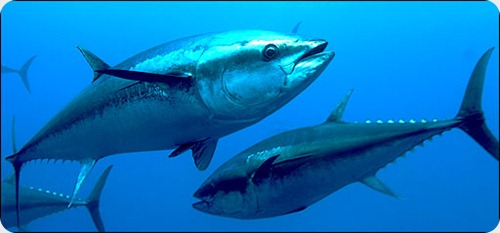
Voy a centrarme en el atún rojo (Thunnus thynnus), especie altamente amenazada a punto de desaparecer debido a la pesca indiscriminada, aclarando antes que el atún que consumimos en los enlatados proviene generalmente de las especies más chicas de carne blanca. El atún rojo (al igual que otros grandes atunes) es muy preciado en las cocinas, en especial, en las orientales por su carne roja. Pesa más de 700 kilos y mide más de cuatro metros de largo. Es muy buscado pues es el ingrediente ideal para el sushi y el sashimi.
Es cazado sin compasión por lo que debe figurar en el top ten de los peces más amenazados del planeta. Vive en el Océano Atlántico norte y en el Mar Mediterráneo. Existe otra especie de atún (Thunnus orientalis) que habita en el Océano Pacífico y que también es conocido como atún rojo; por ende, corre la misma suerte.
Los atunes pertenecen a las pocas especies de peces con sangre caliente que se "calientan" con el constante movimiento de sus poderosos músculos. De esta manera se explica cómo pueden cazar a temperaturas muy bajas manteniendo en su cuerpo cerca de 27 °C (casi como los mamíferos). Los atunes son muy rápidos (alcanzan los 80 kilómetros por hora) y se calcula que en un par de semanas pueden surcar todos los océanos del planeta. Diversos científicos intentaron imitar su configuración anatómica para crear estructuras robóticas similares. Todo esto en vano, pues es imposible igualar esta criatura perfecta.
Los atunes cazan como los lobos, es decir, en manadas cercando a las víctimas y tragan casi todo lo que se mueve en el mar, pues debido a su acelerado metabolismo, necesitan ingerir alimento permanentemente. Su dieta consta de peces, calamares, pequeños tiburones, caballitos de mar, cangrejos y hasta de esponjas de mar. Hace más de un siglo, el atún no era un plato muy preciado y su carne se destinaba para alimentar a gatos y perros. Posteriormente, fue incluido en la pesca de altamar en donde la lucha entre el hombre y los grandes peces alcanza su esplendor. Hace no más de 50 años, se descubrió el gran sabor y calidad de su carne.
Atún querido.
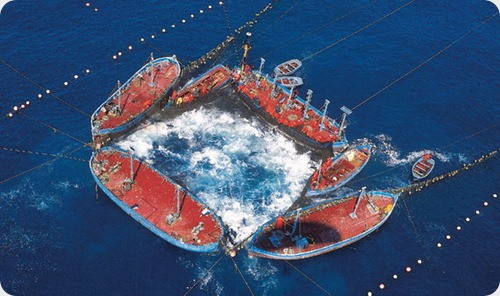
Contrario a los que muchos puedan suponer, en Japón, el pez crudo no ha sido desde siempre un plato típico. En el país oriental se consumían básicamente las especies marinas utilizando las técnicas para su conservación del marinaje, ahumado y secado. Esta situación cambió tras la Segunda Guerra Mundial, pues a través del acceso a las refrigeradoras y congeladoras, la carne de los peces se conservaba por más tiempo. Esto modificó sustancialmente las costumbres culinarias y gastronómicas de los japoneses. De esta manera, el atún, hasta ese entonces menospreciado por los Samurai, pasó a ser un delikatess que alcanzaba el costo y reputación de las trufas o del caviar.
A diferencia de estos dos últimos productos que son escasos y caros, el atún se encontraba (en ese entonces) en grandes cantidades. Poco a poco se convirtió en la estrella de los mejores menús en muchas partes del planeta. En el 2001, un atún llegó a costar en un mercado de Tokio hasta 175 000 dólares. Así, si bien hace 40 años era impensable comer pescado crudo en los Estados Unidos, hoy se encuentran el sushi y el sashimi casi en todas las tiendas de comida rápida, en los supermercados y por supuesto en los restaurantes más caros y refinados. Una cena para dos personas en base a estos dos productos puede costar más de 1 000 dólares. Provecho.
Atún es dinero.
Y claro, como una tajada de atún puede costar varios cientos de dólares, no es de extrañar que miles de embarcaciones se hicieran a la mar en su búsqueda. Al principio, los japoneses se limitaban a pescar en los territorios de sus mares en el Pacífico, pero al notar que grandes cantidades de atunes surcaban el Atlántico norte (más que en el Pacífico) no dudaron en ampliar sus fronteras de pesca. Hace dos décadas se pensaba que existían dos poblaciones de atún rojo sobre el planeta. Una distribuida en Atlántico oeste y otra que ocupaba y se reproducía en las aguas del Mediterráneo.
Bajo esta suposición, en 1969, la comisión de la ICCAT (International Commision for the Conservation of Atlantic Thunas) restringió severamente la cuota de extracción del atún rojo en el Atlántico occidental, mientras que en el Mediterráneo, la restricción de pesca fue muy leve. Ya en los años cincuenta y sesenta algunos científicos habían alertado que el atún no formaba dos poblaciones separadas, sino que se trataba de una sola que utilizaba el Golfo de México y el Mediterráneo para desovar y que sus rutas se cruzaban en el Atlántico.
Actualmente, la situación del atún es cada vez más crítica, pues se capturan especímenes jóvenes (que aún no han alcanzado la madurez sexual) para ser llevados a criaderos marinos hasta que alcancen un tamaño para ser sacrificados y enviados a Japón. En el Mediterráneo esta práctica es usual y se cree que "criando" atunes se combate la sobrepesca. En realidad, lo que se estaría haciendo es arruinar una población silvestre, ya que se captura a los peces antes de que puedan reproducirse y los especímenes adultos en cautiverio casi no crecen, ni se reproducen. Estos criaderos son una real amenaza que solo aceleran la extinción del atún.
Ya en el 2006, la WWF (World Wide Fund for Nature) exigió que cese de una vez por todas la pesca del atún en el Mediterráneo, no obstante, debido a su gran valor en el mercado, dicha situación no se ha dado. La ICCAT ignoró los argumentos científicos para frenar la pesca del atún y mantendrá hasta el 2010 las cuotas de pesca de años anteriores. A partir de ese año, se reducirían en un 20%. Para muchos expertos, estas medidas muy plausibles están condenando al atún a desaparecer. En junio del 2008 se tuvo que frenar la pesca de esta especie en el Mediterráneo debido a su casi desaparición en esa parte del planeta.
Debemos salvar al atún rojo y a los demás tipos de atún de la extinción. Al parecer, la única manera de hacerlo es regulando su pesca y —si es posible y estamos a tiempo—, domesticando a estos depredadores para su crianza y comercio. En la segunda entrega ahondaré en estos puntos. Este magnífico pez merece toda muestra atención. No permitamos la desaparición de esta máquina marina.
Una de las medidas propuestas para frenar la pesca indiscriminada de este pez es el establecimiento de cuotas de pesca. No obstante, al parecer, esto no serviría de mucho, pues la pesca ilegal y el mercado negro son difíciles de controlar. Más del 75% del atún rojo (cerca de 70 000 toneladas) capturado anualmente termina en los mercados japoneses sin importar de dónde procede.
Los propios japoneses no respetan sus leyes y capturan a este pez donde lo encuentren. Con el tiempo, cada vez es más difícil encontrar a estos bólidos marinos. No obstante, la demanda aumenta y con esto los precios también. Su pesca es por eso un negocio atractivo.
Una posibilidad de reducir la pesca sería que los japoneses dejen de consumir sushi y sashimi, lo cual suena casi imposible. Es como si nos dijeran que dejemos de saborear el cebiche. En este escenario solo nos quedaría, al parecer, una posibilidad: domesticar y criar atunes en cautiverio.
Un artículo del biólogo marino John Marra, de la Universidad de Columbia de Nueva York, publicado en julio del 2005 en la revista especializada Nature, titulado: When will we tame the oceans? (¿Cuándo vamos a domesticar al mar?) afirma que la pesca en los mares acabará por aniquilar la fauna marina. Marra sostiene que el hombre ha fracasado en su intento de regular dicha actividad y que en un par de décadas, ya no habrá posiblemente más que regular porque los mares no tendrán casi nada (o nada) para ofrecernos.
Acuicultura.
Marra propone domesticar a las especies marinas. De esta manera se podrían criar especies claves para la industria pesquera y luego comercializarlas. No obstante, la acuicultura que se viene realizando es dañina (en muchos casos), porque contamina las costas y debilita las poblaciones actuales de peces silvestres mediante la transmisión de enfermedades y el contacto con sustancias tóxicas. Para evitar esto, Marra sugiere el uso de criaderos en alta mar, es decir, lejos de la costa y con superficies extensas utilizando redes y estructuras que permitan que estas "grandes jaulas" puedan ser movilizadas.
En lo que respecta al atún, Marra propone la captura y crianza de alevinos para luego ser capturados según la demanda y cuando tengan el peso adecuado. Todo esto bajo un adecuado plan de manejo que asegure una continuidad de la especie y hecho de tal manera que no afecte su ciclo natural. Según esta propuesta, si no se domestica al atún rojo y a los demás atunes, estos desaparecerán en los siguientes años. Alarmados ante tal situación, la Unión Europea viene apoyando proyectos de investigación y crianza de atunes e incluso ya ha anunciado algunos avances al respecto.
Así por ejemplo, científicos alemanes han experimentado con atunes en el Mar Mediterráneo, específicamente en las costas sureñas de Italia. Los resultados son positivos pues se logró colectar diversas crías a través de un tratamiento hormonal. Una de las primeras experiencias en la crianza comercial del atún se inició hace unas décadas mediante el trabajo de la empresa Clean Seas Aquaculture Growout en las costas de Australia. Actualmente, esta compañía trabaja de la mano con expertos europeos en búsqueda de soluciones para este problema. Incluso, el Gobierno Australiano también está apoyando estas iniciativas. Ya se han reportado esperanzadores avances.
La crianza de estas criaturas perfectamente adaptadas al medio acuático se contradice tal vez con su condición de animales excepcionales que dan una gran batalla al ser capturados y que son depredadores por excelencia. Su principal enemigo, el hombre, tendrá que acostumbrarse posiblemente a criar estos seres únicos si no quiere verlos desaparecer. Una verdad lamentable que no puede ser rebatida si se siguen saqueando los mares en todo el planeta. Estas joyas de la hidrodinámica merecen mayor preocupación. Es penosos reconocer que los hemos casi aniquilado.
El atún tiene como únicos enemigos naturales a las ballenas. Su gran capacidad de caza y de movimiento los hace casi invencibles. Lamentablemente para la especie, las técnicas modernas de caza a través de sistemas georeferenciales han hecho más fácil su captura. El hombre le juega una mala pasada, pero es algo a lo que ya tenemos acostumbrada a la naturaleza para bien o para mal. Personalmente, me rindo ante este pez que por todo lo que he leído sobre él me lleva a tomarlo como ejemplo para mostrar las barbaridades que seguimos cometiendo.
Espero que logremos recuperar sus poblaciones, y si tendremos que contentarnos con contemplar al atún como animales de crianza debido a su casi exterminio, no nos queda otra alternativa. Me da mucha ira y consternación enterarme de esto, pero a esta situación hemos llegado.
En casa.
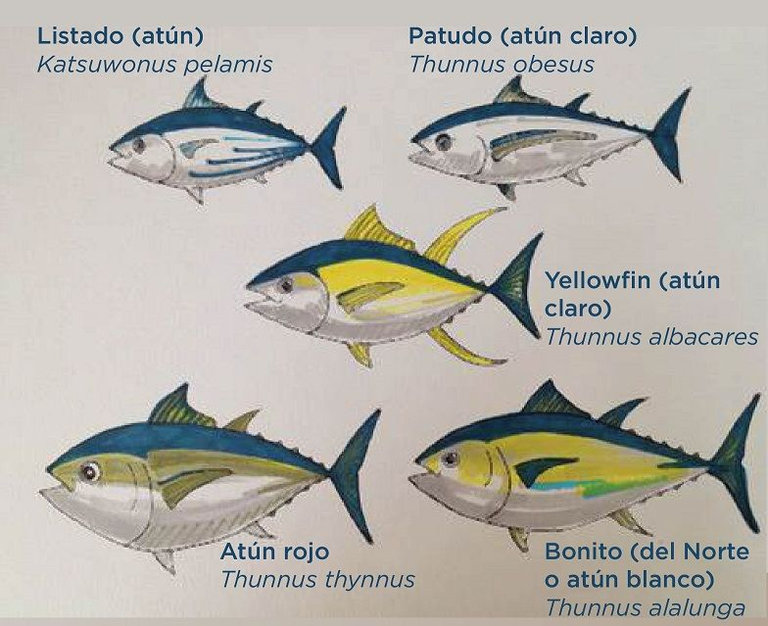
La pesca brutal del atún (y de otras especies marinas) nos lleva a plantearnos el tema en base a nuestra realidad. Es sabido que en nuestro mar se realiza una sobrepesca debido principalmente al poco control y vigilancia que existe en el litoral que ocasiona que no se cumplan las vedas, que se usen redes prohibidas (o chinchorros) y que se pesque con dinamita. Nuestras aguas marinas no escapan al agotamiento de los océanos. En ese contexto, la ministra de la Producción ha anunciado hace unos días que se aplicarán penas carcelarias para los que pesquen con dinamita. Ojalá que esto se cumpla y no quede únicamente en el papel.
Para bien (esperemos), el Ministerio de la Producción ha publicado el 6 y 18 de marzo de 2009 las Resoluciones Ministeriales 103 y 112 respectivamente en donde se prohíbe el uso de “zumbador”, “volador” y “samuyo”, así como del “chinchorro” para la extracción de recursos hidrobiológicos y pesca en todo el litoral. Esperemos que se ponga mano dura y que se respeten estas disposiciones si queremos dejarle algo a las futuras generaciones.
Pero no solo es responsabilidad del Estado velar por los recursos naturales, el ciudadano de a pie debe ser también partícipe de la vigilancia de nuestra flora y fauna. Todos estamos involucrados en esta tarea pues debemos ser conscientes de nuestra responsabilidad histórica sabiendo del escenario nada bueno que se cierne sobre nosotros. Contribuir a la preservación de nuestra diversidad biológica es construir mejores bases para el futuro.
Finalmente, es recomendable darle una revisada a la propuesta de política nacional del ambiente publicada en el portal electrónico del Ministerio del Ambiente a fin de comentar dicho documento y enterarnos de qué es lo que se piensa hacer en lo referente a la pesca y a otros aspectos de interés.
Source images / Fuente imágenes: Crónicas de un Mundo en Conflicto.
Source initial image / Fuente imagen inicial. Unsplash by jirayu koontholjinda
Estas recetas y tantas otras publicadas en #BLURT las pueden encontrar en mis blogs en italiano, inglés y español. Más de 5.000 recetas para darle fantasía y color a tu mesa y hacer una figura digna de un/a chefs con tus invitados.
These recipes and many others published in # BLURT can be found on my blogs in Italian, English and Spanish. More than 5,000 recipes to give fantasy and color to your table and make a figure worthy of a chef with your guests.
Y como siempre me despido de todos con un:
And as always I bid you all farewell with a:

Mis Blogs y Sitios Web / My Blogs & Websites:
- La Cucina di Susana.
- Cucinando con Susana
- El Mundo de los Postres
- Crónicas de Un Mundo en Conflicto.

Upvoted. Thank You for sending some of your rewards to @null. Get more BLURT:
@ mariuszkarowski/how-to-get-automatic-upvote-from-my-accounts@ blurtbooster/blurt-booster-introduction-rules-and-guidelines-1699999662965@ nalexadre/blurt-nexus-creating-an-affiliate-account-1700008765859@ kryptodenno - win BLURT POWER delegationNote: This bot will not vote on AI-generated content
Thank you for supporting my content with your vote @ctime.